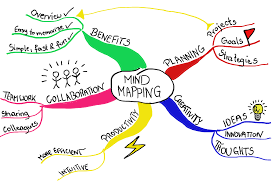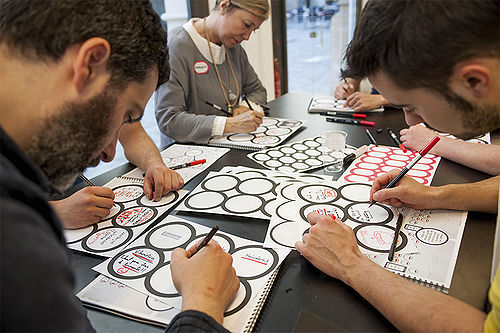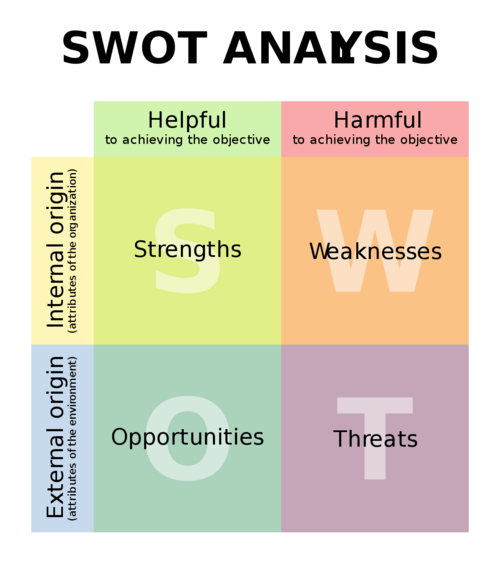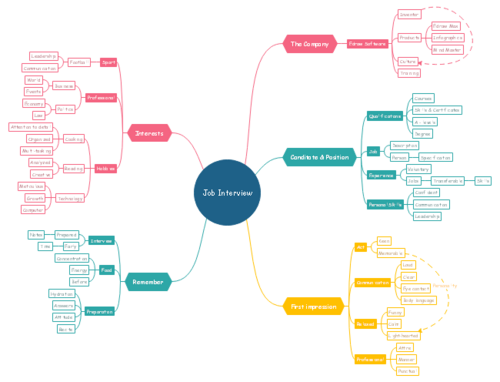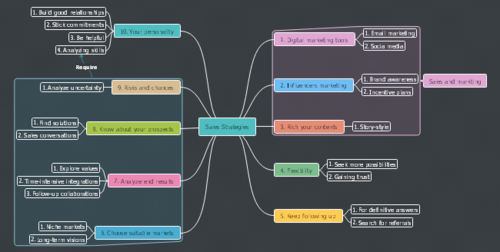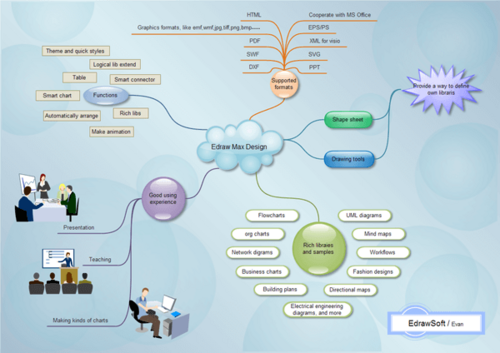Brain Storming Technique
Contents |
Abstract
- History:
Brainstorming as an idea for the first time emerged back in 1942. The term was introduced by Alex Faickney Osborn, founder and advertising executive of the US advertising agency BBDO. In fact, brainstorming was introduced as a creative technique inspired by the working atmosphere in BBDO. Namely, during his time in the company, Osborn’s observations of the everyday work in the office took him closer to developing this creative technique. He found out that during the company’s meetings and discussions, all employees were not proposing creative Ideas, methods or solutions, which resulted in poor meetings closings.
Business meetings are supposed to be an opportunity to set goals and objectives, present and define problems, propose and discuss ideas, and in the end, work toward realizing them. Osborn was aware that the conventional business meetings he and his colleagues held didn’t include an exchange of fruitful ideas and were usually suppressing people’s spontaneity and the ability of free-thinking. This inspired him to establish new basic principles of conducting effective meetings that will be based on freedom of mind and creative thinking. [1]
In 1998, a review of 50 studies on brainstorming was conducted by Scott G. Isaksen, of the creativity research Unit of the creative problem-solving group in Buffalo, New York. The studies examined by Isaksen were among the most prominent ones from 1958 to 1988. Their review revealed that brainstorming was probably the most researched creative thinking technique, And yet the least understood [2]
Purpose
The purpose of brainstorming is to generate ideas and share knowledge to solve a particular commercial or technical problem. The participants are encouraged to think freely without Interruption.
Having a clear idea of the topic to be addressed is critical to creating a successful brainstorming session. A topic that is too specific can restrict thinking, while an ill-defined topic will not produce enough directly applicable ideas.
Defnition:
The concept of brainstorming includes defining a simple or a complex problem for which solutions are generated from different ideas that are later accepted or rejected. the participants in the process of brainstorming present and reveal new ideas as potential solutions for a specific problem. in this Process, brainstorming helps the stimulation of the human mind towards creative problem-solving.
Osborn’s approach to brainstorming and his few simple rules from the beginning until this moment have helped in solving many important issues. Brainstorming as a group activity has become a revolutionary technique that can find its use in both small and large enterprises regardless of the industry in which they are operating. Moreover, it can be beneficial for individuals who are in need of a solution for a specific problem.
This creative thinking technique as a group activity usually starts with a gathering of a group of people. As an informal method of problem-solving, group brainstorming stimulates creative thinking. The proposals that come up in these constructive meetings can provoke interesting and unusual ideas that Later could become a creative solution to a problem. [3]
Big Idea
- Types of brainstorming:
1- Individual Brainstorming:
Self brainstorming includes storming by yourself, it takes a different approach than group storming as it opens the space and opportunities for those introverts who experience idea blockage in group work to produce a wider and bigger variety of ideas. being on your own can give the sense of flexibility and comfort also giving the space to discover a variety of simple, weird or complex ideas which usually would have felt afraid to present in order not to get judged or criticized.
2-Group Brain Storming:
Consisting of a group of people and while keeping it within the rules, group brainstorming is the most efficient as it generates a wider and bigger quantity of possible solutions to the facing problem, the more the group members the more ideas available to build up upon and in the end more areas and possibilities to discover. opposite to individual brainstorming, group brainstorming clears the way for those individuals who face idea blockage during self idea generation, which in this case will limit the creativity or passion towards generating possible outcomes and solutions.
3-Structured brainstorming:
Members of the group will sit in a circle. The leader facilitates the brainstorming. The facilitator will write their ideas in a rotational form on the board. This exercise will be carried out in particular order till each person contributes an idea. If a member is not ready with his/her idea it can pass, later he or She may provide an idea Or pass again.
4-Unstructured brainstorming: Members of the group can sit in a circle or in a classroom in any form of arrangement. There is no order of response. The facilitator will motivate everyone to provide his/her idea.[4]
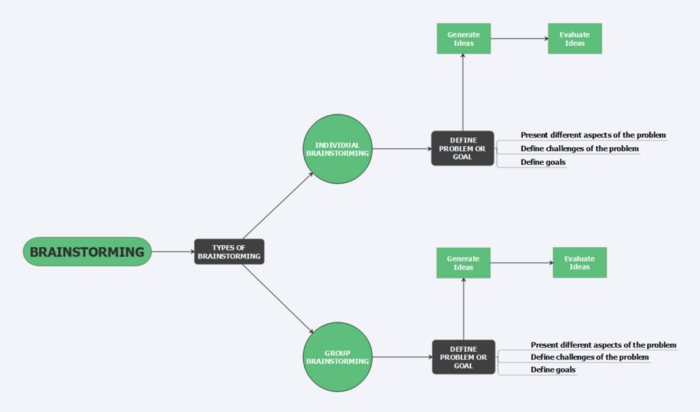 Figure 1:Types of BrainStorming.[5]
Figure 1:Types of BrainStorming.[5]
- Advantages:
There are many benefits to brainstorming as it is one of the most useful tools for problem-solving process and helping in achieving better communication in the meanwhile, one of the major benefits:
1-Encourages Creativity:
Brainstorming creates a lot of ideas and promotes organizational innovation. It broadens members' thinking so that they can come up with the most creative solutions to the problem.
it can provide a variety of options since Ideas are formed in groups rather than individually.
2-Generates bigger quantity of ideas:
Since the process is made by a group, and if the moderator motivates the members to produce the most amount of ideas in the shortest timeframe, this creates the maximum amount of ideas possible and guarantees a good quantity.
3-Participation builds Responsibility:
Since the process is a collaborative experience, all members of the meeting will participate in the idea generation. this creates a sense of ownership and responsibility towards the issue or project. which will then increase the passion and motivation to reach even a higher point of creativity and production.
4-Easy to setup:
The brainstorming techniques which will be mentioned below, are once acquired easy to set up, understand and use. which reduces the sense of confusion and time-wasting.
5-Saves Resources:
Since most of the brainstorming techniques are digital or basic office material, in addition to not requiring much time and resources to set up. it guarantees saving time and money other than other consulting options.
- In order to make sure that these benefits are established and acquired several steps or rules has to be done.
These rules and suggestions are carried out or set by the organiser which can be the team leader, supervisor or even a manager, they are made to make sure to get the most out of the brainstorming session.
An example of some of the rules:
1-Set a deadline: Setting a deadline helps improve the speed of the idea generation process
2-Define the main problem/goal: Start the process with a clear definition of the needed goal to achieve or problem to solve, in order to focus the ideas on the desired outcome.
3-Deny or block any Idea criticism: By working with the principle that there are no bad ideas, the members involved would not feel shy or preserve some of the ideas, which might define the needed solution. in addition to removing chances of conflicts or bad feelings in working the environment.
4-Quanitity over quality: Keep motivating even the simplest ideas in order to produce the biggest number of possible solutions which will be later on filtered in the process.
5-Use variety of tools: By using the big variety of tools in hand and digitally the members can achieve better and more organised solutions, this also helps to structure the thought process and solution filtering in the next steps such tools are: SWOT which will be discussed in the application's part.
Application
PHASES OF BRAINSTORMING:
Three phases of effective Brainstorming are as follows: 1. Generation of ideas 2. Discussion of the produced ideas 3. Final evaluation of the presented ideas
Phase 1: GENERATION OF IDEAS:
1. Preparation. Know your goals. Clearly define where you are now and where you want to be.
2. Prepare an executive summary that can be quickly scanned for the key points you need your team to focus on.
3. Now decide whom to invite.
4. Provide the executive summary with the meeting request, and ask them to bring three ideas to share during the session.
5. Reserve ample time for your group to be effective, yet focused. Motivation decreases with each follow-up session you have to add.
Phase 2: DISCUSSION OF THE PRODUCED IDEAS:
1. Facilitation. Like any meeting, a brainstorming session needs structure. Designate a facilitator to encourage participation, act as a timekeeper.
2. Have a note-taker write ideas on a whiteboard or easel pad. This will have one major positive Consequence – visual proof of progress.
3. Before ending the session, make sure there are clear, agreed-upon takeaways and next steps. everyone needs to leave the session knowing his or her role in the next phase.
Phase 3: FINAL EVALUATION OF THE PRESENTED IDEAS:
1. Follow Through. After the session, share the most viable ideas, separating them by those more easily implemented vs. those tabled for further discussion. If possible, take action on one or two ideas immediately, so everyone can see the result of their work.
2. Don’t let the good ideas fall into a black hole. make sure a single person, strong in follow-through, is responsible for advancing the ideas and achieving your original goals. this person might be you, but can be a key staff person.
3. Communicate progress with the entire team, even those who have no further role after the session. Keeping colleagues informed shows them you value their time and knowledge. [6]
Examples of Brainstorming uses in Managment:
1- Problem Solving
-Investigating a variety of possible solutions creates a wider capacity of solutions and limits the risks fks: Designing a new concept or integrating a product into a new environment.
2- Marketing Managment advertisements
-Brainstorm a variety of concepts and areas of interest. examples: a new marketing campaign for Apple, Microsoft, TV series.
3- Project Management -Brainstorming a variety of possible changes to the system of production -More ideas means more solution that can be found -Gives a better idea of where people at in the project fks: Brainstorming in root cause analysis, current bottlenecks and possible solutions for almost any project in hand.
4- Any other obstacle-solution scenario in real life.
Famous Brainstorming techniques
The essential criterion of brainstorming is extracting each concept and the concept procedures to show up an entire path of action. The situations, deliverables, concepts, and goals of brainstorming are dynamic and want particular tactics to get the innovative brilliance going. these are some of the most famous brainstorming techniques tools:
1. Mind Mapping:
A mind map is an image that contains any sort of graphical element to express an idea. it may include to-do lists, thought clouds, doodles, notes, blueprints, key points, information, and anything else that helps bring clarity to an objective. the primitive technique to create mind maps is to take a piece of paper, some markers, and jot down the idea. Use one-worded labels first to write down the main topic and then work your way into labelling the relative layers of challenges, resources, considerations, etc. as subtopics.[7]
Figure 2: Mind Mapping example[8]
2. Brainwriting:
Brainwriting is the natural process of having each group member write down their ideas and inputs, and submit anonymously to the matter on the table. This process is different from the traditional group discussions exercised in brainstorming sessions. The writing down of opinions isolates an idea from any additional exchange of acoustic, direct communication, as is radical in verbal conversations. This technique is devised to ward off impacts of counteraction, partiality, negation, or criticism, based on whose idea it is. But it is more about establishing a flat approach towards the ideation. Therefore, the anonymity of contributors is not always the primary concern of brainwriting, it is also to have a precise conveyance of ideas when it comes from multiple directions, such as this content marketing strategy above, which depicts multiple inputs from people and departments, yet still, holds up a cohesive Objective.[9]
Figure 3: Brainwriting [10]
3.SWOT Analysis:
SWOT template offers the possibility of assessing the relative impact of each strength, weakness, opportunity and threat. Once the strengths, weaknesses, opportunities and threats that need to be addressed have been identified, they can be transposed onto the 2nd template which is almost the same as the first one but only focuses on the internal and external factors. then the final steps in the process involve exploring ways of developing and making the best use of strengths and using them to exploit opportunities, and finding ways of reducing weaknesses and containing threats. the value of change tools such as the SWOT analysis is that they can help to ensure that those leading change does not adopt a blinkered approach and ignores key data
Figure 4: SWOT Template][11]
4. Role Storming:
Role Storming is a practical approach to considering what someone else might do in a similar situation. it is recommended that you engage in role storming sessions with someone you trust, with a bit of favourable judgment. Such consulting teachers or educational advisors will take note of their Accounts in a single mind map, or make career choices.
Figure 5: Role-storming
5. Step Ladder Brainstorming:
Step ladder brainstorming is a modern concept to exercise teams and classes that are not adequately communicative or expressive. the drill follows the course of defining a problem or challenge to a group and then directing all but two members to leave the room.
First, the two members are asked to share their ideas; then, a third member is called back in the place to share his/her input exclusively. This process is repeated with the rest of the members entering the room, one by one, and filling the room back up. Through this technique, every member can participate in the brainstorming, exclusively as well as collaboratively with a little help from a teacher, trainer or manager.
Figure 6: Step-ladder brainstorming
6. Design Charrette:
Figure 7: Design charratte method
Charrette is a brainstorming technique that is much similar to workshops. It typically involves dedicated collaboration by a group or several groups working collectively towards a project, a cause, or a study program. Charrettes follow a target-oriented course, that has to be accomplished within the set time. This kind of brainstorming is typically endorsed for creative endeavours.[12]
Osborns method of Brainstorming
Osborn mentioned four general rules of brainstorming to increase the overall creativity of the group.
1- Focus on quality: This means maximum quantity breeds quality. If a large number of ideas are generated it helps to produce an effective solution. It generates ideas for the solution of the problem.
2- Don t criticize: Don’t criticize produced ideas. Hold the criticism or evaluation of generated ideas by group members. It is important to feel free to generate more ideas by members. If ideas are evaluated or criticized then members will not present ideas freely. They feel shy to ask something new.
3- Welcome unusual ideas: record all ideas, unusual ideas are also welcome. It can help to generate more ideas. Unusual ideas can assist to create better ideas for another member of the group.
4- Improve ideas: Good ideas may be combined and generate single Better idea and put it for further discussion or solution.[13]
Limitations
-Not absolutely each person actively takes component in brainstorming.
-Some contributors are greater quiet and don`t like to talk spontaneously in groups.
Other contributors talk too much.
-Some contributors want longer to apprehend the subject and can`t right now offer ideas.
-It`s not viable to cowl all risks with brainstorming.
-The results of brainstorming are largely groupthink and not necessarily individual thoughts or ideas.
Conculsion
Brainstorming is a technique used to generate ideas that allow project managers and team leaders to be creative in their approach to problem-solving. During the process there are no boundaries to ideas and the objective is to create as many possible solutions as possible. The process involves Everyone in the group, generates energy and as no idea is a bad idea allows gives team members permission to put forward ideas without fear of being criticised. Even though it has all these pros it also has some cons that are limiting in some scenarios, so it is always the responsibility of the organizer To decide whether to go through it and How much time is spent on it. Finally, the whole concept is just a tool that is used to further generate ideas and it also requires after brainstorming data process which includes data filtering, decision making, decision matrix analysis or just some simple voting in order To get the most of it.
Annonated Bibliography
-ResearchGate. (n.d.). (PDF) Brainstorming technique: Innovative Quality Management Tool for Library
This paper deals with light of Obsornes brainstorming rules, process, flowchart of brainstorming, benefits, need in library etc. We explore about how to organize and run effective brainstorming session in library. It will also assist in research to solve problem in every stream.
-Regent University. (n.d.). The Journey of Brainstorming. [online]
The purpose of this paper was to trace the origins of brainstorming, to understand how the process evolved from its introduction in 1953 by Alex Osborn, a creativity theorist, and businessman, and to identify how and why brainstorming has come to be used today. After reviewing several studies of brainstorming and exploring its history.
-iMindQ. (n.d.). Brainstorming
iMindQ is a mind mapping tool that finds a great use in brainstorming. It is developed with the purpose to simplify the process of generating and organizing ideas and thoughts visually. As an easy-to-use brainstorming software, it allows users to create mind maps using visual diagrams for connecting topics, ideas, and information.
references
- ↑ [Brainstorming iMind] https://www.imindq.com/brainstorming/
- ↑ [Alex Osborn the journey of Brain storming] https://www.regent.edu/journal/journal-of-transformative-innovation/the-history-of-brainstorming-alex-osborn/#about-the-author
- ↑ [BrainStorming iMind] https://www.imindq.com/brainstorming/
- ↑ [Brainstorming]https://www.researchgate.net/publication/325594636_Brainstorming_technique_Innovative_Quality_Management_Tool_for_Library
- ↑ [BrainStorming iMind] https://www.imindq.com/brainstorming/
- ↑ [Three phases of effective brainstorming]https://www.memphisdailynews.com/news/2016/feb/17/three-phases-of-effective-brainstorming/
- ↑ [ Brainstorming examples and techniques] https://www.edrawmind.com/article/brainstorming-examples.html
- ↑ [ Mind Mapping] https://www.mindmeister.com/blog/tony-buzan-tribute/
- ↑ [ Brainstorming examples and techniques] https://www.edrawmind.com/article/brainstorming-examples.html
- ↑ [ Mind Mappinghttps://manualthinking.com/methods/brainwriting/
- ↑ [ SWOT template]https://en.wikipedia.org/wiki/SWOT_analysis
- ↑ [ Brainstorming examples and techniques] https://www.edrawmind.com/article/brainstorming-examples.html
- ↑ [Brainstorming]https://www.researchgate.net/publication/325594636_Brainstorming_technique_Innovative_Quality_Management_Tool_for_Library
